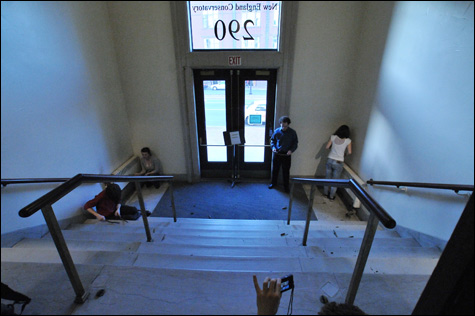
KIDS IN THE HALL: Only now, at NEC, it’s the “Christian Wolff Performance Space.” |
The timely highlight of Gil Rose’s latest BMOP (Boston Modern Orchestra Project) concert, “Strings Attached,” was a new/old piece (2004, revised 2009) for two string orchestras by Scott Wheeler now called Crazy Weather — the new title taken from a John Ashbery poem that begins, “It’s this crazy weather we’ve been having.” Thunderous snaps of antiphonal bass strings set off pizzicato raindrops that turn into Allegro sheets of musical rain. Of course, it’s an emotional landscape, as the exquisite Adagio makes even clearer. Slowly overlapping high violins create pungent harmonies, with delicate pizzicato punctuation. And in the “Steadily driving” third movement, the contrast — or argument — between flowing legato and slashing staccato becomes more intense and syncopated, until finally the storm is over and all the tension just dribbles away.
There was also the astounding violist Kim Kashkashian in Israeli composer Betty Olivero’s affecting folk-based lamentation Neharót, Neharót, with accordion (Katherine Matasy), double string ensembles, and tape, and Milton Babbitt’s 1967 Correspondences, for strings and synthesized tape, which alternates delicate, bell-like pointillism with rude raspberries — hard as ever to follow but here, for once, delightful to listen to.
The most traditional piece was the newest: NEC concerto-competition winner Nathan Ball’s Stained Glass, with pretty Copland-esque tunes floating over an Adams-like repeating minimalist bass line.
Stephen Drury and the New England Conservatory spent a week devoted to avant-garde master Christian Wolff, associate of John Cage and Merce Cunningham, and classicist (he was actually my graduate-school Latin teacher). The second of each day’s three concerts featured performances of Wolff’s most experimental and improvisatory work in the newly christened “Christian Wolff Performance Space,” the hallway near NEC’s Beethoven statue. In Play, from Wolff’s four-decade-old Prose Collection, six students chose their own instruments (harmonica, beer bottle, whistle, baritone sax, toy mandolin, and synthesizer, plus strings), and they followed not a score but Wolff’s prose instructions. Ambient hallway noises — cell phones, vocalizing — added to the mix. In Peace March (Exercise #26) (1988), at Brown Hall, the understated rat-a-tats of student snare-drummer Trent Leasure accompanied Wolff’s own sustained chords on the melodica (“blow organ”) — or was it the other way around? Placing this composer in a context of American experimentalism, the marvelous Borromeo String Quartet delivered Charles Ives’s early From the Salvation Army (1898–1902), whose layered sound world (including quotations from hymns) anticipates Wolff’s.
This contextualizing went even farther at the Isabella Stewart Gardner Museum, where Drury’s Callithumpian Consort offered a semi-staged reading of Bertolt Brecht’s didactic short play The Exception and the Rule, with Wolff’s new song settings and incidental music. The fresh, spiky, consistently surprising score gives the preachy play dimension and edge — yet it sounds nothing like Brecht’s most famous musical collaborator, Kurt Weill. The actors weren’t ready for prime time; some of the best speaking came from the Callithumpians themselves.
Preceding the play was Henry Cowell’s 26 Simultaneous Mosaics (1963), glittering fragments that Cowell instructs the performers to play in a different order each time, and Ives’s playful and moving Piano Trio, with pianist Drury, violinist Gabriela Diaz, and cellist Ben Schwartz balancing the kaleidoscopic layers even better than Emanuel Ax, Colin Jacobsen, and Yo-Yo Ma did when they accompanied Mark Morris’s choreography in Empire Garden. And then, conductorless, the Callithumpians, with Keith Rowe on electric guitar, ended with British avant-gardist Cornelius Cardew’s technically mysterious, repressed, and darkly seductive Treatise (1963-’67).